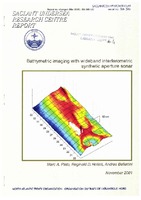| dc.contributor.author | Pinto, Marc A. | |
| dc.contributor.author | Hollett, Reginald D. | |
| dc.contributor.author | Bellettini, Andrea | |
| dc.date.accessioned | 2018-10-11T14:09:13Z | |
| dc.date.available | 2018-10-11T14:09:13Z | |
| dc.date.issued | 2001/11 | |
| dc.identifier | 13157 | |
| dc.identifier.govdoc | SM-386 | |
| dc.identifier.uri | http://hdl.handle.net/20.500.12489/575 | |
| dc.description.abstract | A new approach to interferometric sonar is presented, based on time delay estimation using shortterm correlation of the seafloor backscatter. It is most suited to signals with large relative bandwidths and long interferometric baselines compared with the acoustic wavelength, that is, to the case in which the conventional processing has known limitations. The theoretical accuracy of the depth estimates is derived and validated using both Monte Carlo simulations and data from a trial carried out on an underwater rail in very shallow water. The interferometric sonar operated between 120 and 1880 kHz with two 32-element receiving arrays of length L=26.7 cm and a vertical baseline of D=21.7 cm. The approach is extended to interferometric synthetic aperture sonar (InSAS), and experimental results are presented at range intervals around 25 m, 50 m, and 75 m in 12 m water depth. It is shown that the increase in spatial resolution provided by the SAS processing considerably improves the accuracy of the depth estimates. A solution to the micronavigation problem based on the Displaced Phase Centre Antenna (DPCA) technique is presented which also corrects roll-induced distorsions in the InSAS bathymetric map. | |
| dc.format | vi, 26 p. : ill. ; 17 fig. | |
| dc.language | English | |
| dc.publisher | NATO. SACLANTCEN | |
| dc.subject | Synthetic Aperture Sonar (SAS) | |
| dc.subject | Shallow water | |
| dc.subject | Bathymetry | |
| dc.title | Bathymetric imaging with wideband interferometric synthetic aperture sonar | |
| dc.type | Scientific Memorandum (SM) | |
